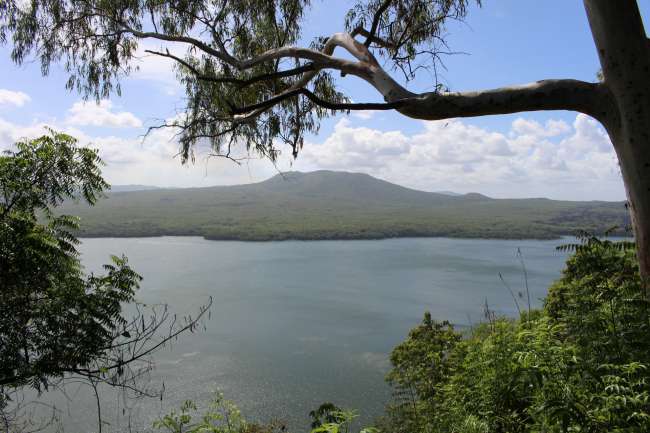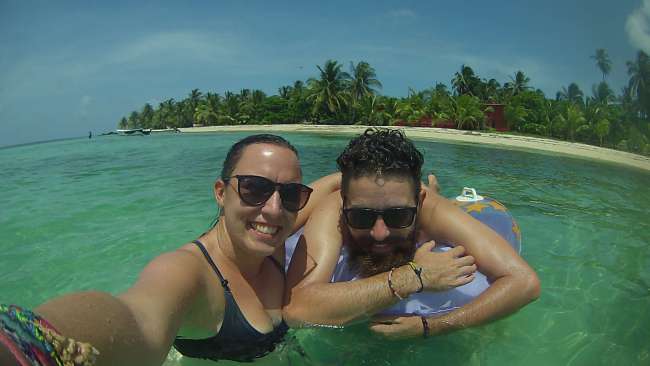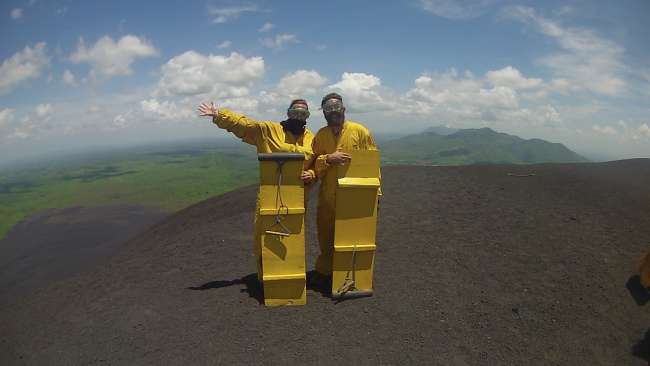Part 2 Nicaragua
Diterbitkeun: 12.06.2017
Ngalanggan Newsletter
Continuation of the Nicaragua report. All the pictures are in Part 1!
After about 2 weeks, we had to say goodbye to the beautiful Corn Islands. Back in Managua, we picked up our luggage and quickly left the ugly capital heading towards the coffee highlands. Our destination was Matagalpa, where we visited a fair-trade coffee plantation with an adjacent cloud forest. Unfortunately, it was not the picking season, but our guide explained the different steps and what is important in coffee production. In the end, we got to taste the coffee, and Tömmi judged it as "very good," while I struggled to drink it and found the tour very interesting because Fair Trade in this case really meant fair compensation and many additional benefits such as health insurance and education for the children. After that, we walked around Selva Negra, a forest named after its German owners. The forest doesn't really resemble our Black Forest, but it is home to a lot of black howler monkeys, which accompanied us with their deafening screams, although they didn't show themselves up close.
Otherwise, we enjoyed the culinary delights in Matagalpa, especially the cheesecake, which is available everywhere, impressed me. However, Tömmi's stomach was giving him a hard time again, and we slowly suspected that he had contracted worms or other parasites. Tömmi took it sportingly and nicknamed his annoying worm Frauke and declared war on the little pest 😉 In Matagalpa, we also wanted to climb a viewpoint from where you have a beautiful view of the whole coffee highlands, but our hostess forbade us because there are regular robberies on the hiking trail. So we took a taxi up and walked down on foot, as advised by the security officials up there, according to our hostess. The taxi driver also warned us emphatically about the frequent robberies, so we took it seriously. When we reached the top, we enjoyed the beautiful panoramic view of the green hills of Selva Negra, but as it was getting closer to sunset, we wanted to start our descent. However, the policeman armed with a machine gun prohibited us from walking down and said that we had to take a taxi. Neither he nor his colleagues had a taxi telephone number, but they told us to wait or walk the "normal" way, which we had been warned against before, and we didn't want to leave our phones and cameras with a wannabe gangster. A little frustrated, I turned to a birthday party that was just breaking a piñata and asked for help. After some back and forth with countless phones that all seemed not to work, we were finally able to get help, and shortly thereafter, the saving taxi arrived.
From Matagalpa, we went to Estelí, a village that gained great importance during the revolutionary time. Many murals tell the story of the Sandinistas, who started the rebellion against the dictatorship here. However, Estelí was just a stopover for us because we actually wanted to go to the northern border with Honduras, where the Somoto Canyon snakes. In Estelí, we wouldn't have stayed longer either because the whole city seemed to be filled with incredibly loud sound systems that blared at an inhuman volume that today is Mother's Day. Mother's Day is a very important holiday in Nicaragua but is celebrated on the last Sunday in May due to a birthday overlap with the wife of the former dictator. I also doubt that the Nicaraguan mothers like this noise on their holiday, but maybe we understand the term holiday a little differently in Germany.
We then took the express bus to Somoto, where we were picked up by a member of the family that revitalized tourism in the canyon a few years ago. The family offers simple rooms, delicious food, and a guide from the family clan who shows you how canyoning works. I've been wanting to try canyoning for ages, and now I finally had the opportunity. Tömmi, of course, was only confronted by me with the fact that he had to climb, swim, and jump through a raging river for 4 hours. He would have preferred the option of "floating down the river in a tire," but he dutifully put on his Lycra shirt and life jacket and was ready to be surprised. Of course, we were lucky again on the morning of our adventure: it had rained torrentially in neighboring Honduras at night, causing the water in the canyon to rise dramatically and create life-threatening whirlpools, so one guide would not have been sufficient. So we joined three groups together and ended up with several tourists but also enough guides and safety ropes for canyoning. Four hours and many bruises later, we were totally full of adrenaline and glad we did the tour. The river was quite challenging, and even with a life jacket, you were often pulled under water for a long time by the current, but it was a lot of fun. We never found the ideal route recommended by the guides, collided with several rocks, and missed the right exit due to the strong current, but we always had a big smile on our faces. Tömmi was able to shine again with jumps from 8 and 12 meters, and I saved a little lizard's life whose coconut shell had capsized, and it couldn't make it to shore on its own.
After lunch, we hopped back on the chicken bus to Estelí, from where we went to the university town of León.
León is a very pleasant city with many beautiful colonial buildings and even more churches. Above all, León, like Estelí, is the Sandinista stronghold, and the many murals, posters, and slogan-printed shirts of the students show that the atmosphere here is very revolutionary. Unfortunately, the Sandinistas now stand for exactly what they fought against during the revolution from 1978 to 1990: corruption, nepotism, and autocracy. The plan for the Nicaragua Canal from the Caribbean Sea to the Pacific Ocean, which cuts through the entire country, also agitates people against the government today. The fact that Nicaragua is the second poorest country in Central America after Puerto Rico is, of course, disliked by many.
Since the annoying Frauke worm was getting worse for Tömmi, we booked a room in an eco-hotel directly opposite the hospital. However, since Tömmi is not a big fan of hospitals, and the locals said that there are good remedies for parasites in the pharmacy, we visited pharmacies and finally relied on 6 tablets that should finally kill Frauke. However, Tömmi, just like his parasites, was more or less incapacitated, so I swam for several hours a day in the eco-saltwater pool and watched the hummingbirds, geckos, and bats catch mosquitoes. A visit to the art museum and a free walking tour were also possible, where the chemistry student Alejandro gave us a crash course in Nicaraguan history and showed us the most beautiful spots in the city.
We finally finished devouring the 6 tablets, and found ourselves with a wooden board at an altitude of 728 meters on Cerro Negro, Nicaragua's youngest and most active fire-spitting volcano. In the background, the volcano chain of Cordillera de los Maibios stretches, to which Cerro Negro also belongs. The bright blue sky stands in stark contrast to the bright green landscape on which the pitch-black volcano sits. In between, the solidified lava waves show where the lava flowed during the last eruption in 1999 into the barren prairie. An adrenaline junkie named Eric Barone had tried to race down the volcano on a bike in 2002 and set a speed record. Unfortunately, the bike broke under him at 172 km/h, as did almost every bone in his body. An Australian found the idea exciting and then looked for other "vehicles" to slide down Cerro Negro. Snowboard, skateboard, refrigerator, car door... nothing really worked until he went back to the good old board, which adventurous tourists now ride down the volcano on a daily basis. Since this action is in the CNN "50 Things for Adrenaline Junkies" list at number 2, we had to try it too. After a rather easy but very windy ascent, during which our guide knew a lot of interesting facts about the volcano chain around León, and a brief look into the steaming crater, we put on our bright yellow Minion suits, put on the appropriate chemical goggles, tied a face mask around our noses to protect against the dust, and waited for the signal to go. I didn't pay much attention to the explanation on how to operate the board because I'm an experienced sled rider after all. That's why I also missed the hint that once you reach a certain speed, you can no longer brake... Tömmi set off first, into the black void, unable to see the end of the track, but he arrived safely at the bottom. Then, some very cautious girls followed who were so slow that we, the waiting ones, almost had a heat stroke. But then finally the go: full of joy, I threw myself down the 41-degree steep slope, demanding everything from my board and suddenly realized that it was going downhill a bit too fast. However, braking really didn't work, and so I shot down the slope at what felt like 70 km/h, completely out of control but with a beaming smile (or filled with a scream of fear) down into the valley. The board scraped over the razor-sharp volcanic rubble, dust and small stones flew around my ears, it had little to do with sledding, but it was incredibly fun 😊
Awesome, despite the crash landing at the end, I wanted to do it again immediately, but unfortunately, we had to get back on the truck that rocked us back to León. In the eco-pool, I got rid of all the volcanic rock that had settled in my ears, nose, eyes, and hair. Definitely a great experience, racing down an active volcano on a wooden board!
Before heading to the airport to go to Costa Rica, we wanted to spend a few days on the Pacific coast, and as the small beach town of Las Peñitas can be reached in 40 minutes by chicken bus, it should be our last stop in Nicaragua for now.
Thanks to the low season, things were very quiet in the surfer village of Las Peñitas, we had the beach to ourselves, and the huge waves even scared away most surfers. We enjoyed our very cool accommodation right on the beach with beautiful hammocks, a pool, a fridge with liters of beer and rum, and everything you need for a few lazy beach days. Mambo, our black guard dog, wanted to eat me at first, but after the first stroke and a piece of breakfast bacon, we became the best friends. Tömmi and I tried to swim in the sea a bit, which became quite exhausting due to the really big waves, but at some point, we discovered the bodyboards, and it became Tömmi's new favorite sport. In the meantime, we took beach walks and a kayak tour through mangrove forests to Isla Juan Venado, a nature reserve for crocodiles, sloths, and sea turtles that come ashore there every August to lay eggs. We didn't see many animals, but I learned that mosquito spray acts like sunburn salve and aluminum foil when exposed to sunlight: hello sunburn! Our guide Philippe, a local fisherman who is very passionate about the island and nature conservation, told us a lot about illegal poaching by the often desperately poor population. Poverty as well as rum and lack of prospects are a problem for many here. The hotels here, which are often fully booked weeks in advance during the high season, are mostly foreign-owned, and those who get a cleaning job there can count themselves lucky. Unfortunately, there were only a few eggs in the turtle conservation station at the moment, but the beach covered with shells was also very beautiful to look at, and Tömmi fished a particularly beautiful specimen out of the waves.
We spent the last few days very relaxed on the beach, watched the surf contest organized by our hotel owner, and prepared for Cuba.
Nicaragua has definitely impressed us more than we expected from such a small country. There probably won't be a blog entry from Cuba because there is hardly any internet on the island. If everything goes according to plan, we will be back home from July 18th. Until then, hasta luego.
T&T
Ngalanggan Newsletter
Waleran

Laporan perjalanan Nikaragua


